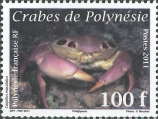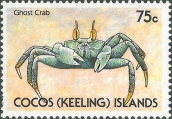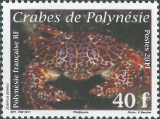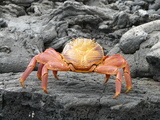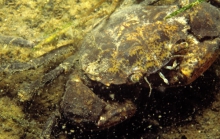Decanet taxon details
Rhithropanopeus harrisii (Gould, 1841)
107414 (urn:lsid:marinespecies.org:taxname:107414)
accepted
Species
Panopeus wurdemannii Gibbes, 1850 · unaccepted > junior subjective synonym
Pilumnus Harrisii Gould, 1841 · unaccepted > superseded combination
Pilumnus tridentatus Maitland, 1874 · unaccepted > junior subjective synonym
marine, brackish, fresh, terrestrial
recent only
(of Pilumnus Harrisii Gould, 1841) Gould, A.A. (1841). Report on the Invertebrata of Massachusetts, Comprising the Mollusca, Crustacea, Annelida, and Radiata. <em>Published Agreeably to an Order of the Legislature, by the Commissioners on the Zoological and Botanical Survey of the State. Folsom, Wells, and Thurston, Cambridge,.</em> xiii + 373 pp., 15 pls., available online at http://www.biodiversitylibrary.org/item/76081 [details] 
Depth range Shallow-waters (0-100 m)
Distribution North-east American, brackish water, species introduced into south Baltic, Dutch and other European estuaries, and...
Distribution Brackish water species.
Distribution Miramichi estuary, New Brunswick to Gulf of Mexico
Depth range Shallow-waters (0-100 m) [details]
Distribution North-east American, brackish water, species introduced into south Baltic, Dutch and other European estuaries, and...
Distribution North-east American, brackish water, species introduced into south Baltic, Dutch and other European estuaries, and particularly docks warmed by power station effluents, e.g. Swansea and Southampton. [details]
Distribution Brackish water species.
Distribution Brackish water species. [details]
Distribution Miramichi estuary, New Brunswick to Gulf of Mexico
Distribution Miramichi estuary, New Brunswick to Gulf of Mexico [details]
DecaNet eds. (2025). DecaNet. Rhithropanopeus harrisii (Gould, 1841). Accessed at: https://www.decanet.info/aphia.php?p=taxdetails&id=107414 on 2025-09-11
Date
action
by
original description
(of Pilumnus tridentatus Maitland, 1874) Maitland, R.T. (1874). Naam lijst van Nederlandsche Schaaldieren. <em>Tijdschrift der Nederlandsche Dierkundige Vereeniging.</em> 1(3): 228-269. [details] 
original description (of Panopeus wurdemannii Gibbes, 1850) Gibbes, L.R. (1850). On the carcinological collections of the United States, and an enumeration of species contained in them, with notes on the most remarkable, and descriptions of new species. <em>Proceedings of the American Association for the Advancement of Science.</em> 3: 165-201. [details]
original description (of Pilumnus Harrisii Gould, 1841) Gould, A.A. (1841). Report on the Invertebrata of Massachusetts, Comprising the Mollusca, Crustacea, Annelida, and Radiata. <em>Published Agreeably to an Order of the Legislature, by the Commissioners on the Zoological and Botanical Survey of the State. Folsom, Wells, and Thurston, Cambridge,.</em> xiii + 373 pp., 15 pls., available online at http://www.biodiversitylibrary.org/item/76081 [details]
context source (Introduced species) Katsanevakis, S.; Bogucarskis, K.; Gatto, F.; Vandekerkhove, J.; Deriu, I.; Cardoso A.S. (2012). Building the European Alien Species Information Network (EASIN): a novel approach for the exploration of distributed alien species data. <em>BioInvasions Records.</em> 1: 235-245., available online at http://easin.jrc.ec.europa.eu [details] Available for editors
context source (Schelde) Maris, T., O. Beauchard, S. Van Damme, E. Van den Bergh, S. Wijnhoven & P. Meire. (2013). Referentiematrices en Ecotoopoppervlaktes Annex bij de Evaluatiemethodiek Schelde-estuarium Studie naar “Ecotoopoppervlaktes en intactness index”. [Reference matrices and Ecotope areas Annex to the Evaluation methodology Scheldt estuary Study on “Ecotope areas and intactness index”. <em>Monitor Taskforce Publication Series, 2013-01. NIOZ: Yerseke.</em> 35 pp. (look up in IMIS) [details]
basis of record Türkay, M. (2001). Decapoda, <B><I>in</I></B>: Costello, M.J. <i>et al.</i> (Ed.) (2001). <i>European register of marine species: a check-list of the marine species in Europe and a bibliography of guides to their identification. Collection Patrimoines Naturels,</i> 50: pp. 284-292 (look up in IMIS) [details]
additional source Brunel, P., L. Bosse & G. Lamarche. (1998). Catalogue of the marine invertebrates of the estuary and Gulf of St. Lawrence. <em>Canadian Special Publication of Fisheries and Aquatic Sciences, 126.</em> 405 pp. (look up in IMIS) [details] Available for editors
additional source Pohle, G.W. (1990). A guide to decapod Crustacea from the Canadian Atlantic: Anomura and Brachyura. <em>Canadian Technical Report of Fisheries and Aquatic Science.</em> 1771. 29 p. [details]
additional source Muller, Y. (2004). Faune et flore du littoral du Nord, du Pas-de-Calais et de la Belgique: inventaire. [Coastal fauna and flora of the Nord, Pas-de-Calais and Belgium: inventory]. <em>Commission Régionale de Biologie Région Nord Pas-de-Calais: France.</em> 307 pp., available online at http://www.vliz.be/imisdocs/publications/145561.pdf [details]
additional source Streftaris, N., A. Zenetos & E. Papathanassiou. (2005). Globalisation in marine ecosystems: the story of non-indigenous marine species across European seas. <em>Oceanogry and Marine Biology: an Annual Review.</em> 43: 419-453. (look up in IMIS) [details] Available for editors
additional source Zenetos, A., M.E. Cinar, M.A. Pancucci-Papadopoulou, J.G. Harmelin, G. Furnari, F. Andaloro, N. Bellou, N. Streftaris & H. Zibrowius. (2005). Annotated list of marine alien species in the Mediterranean with records of the worst invasive species. <em>Mediterranean Marine Science.</em> 6 (2): 63-118., available online at https://www.researchgate.net/publication/273213810_Annotated_list_of_marine_alien_species_in_the_Mediterranean_with_records_of_the_worst_invasive_species [details] Available for editors
additional source Felder, D. L., Álvarez. F.,Goy, J.W. & Lemaitre, R. (2009). Decapoda (Crustacea) of the Gulf of Mexico, with comments on the Amphionidacea,. <em>Felder, D.L., and Camp, D.K. (eds), Gulf of Mexico - Origins, Waters, and Biota. Vol. 1. Biodiversity.</em> Pp. 1019–1104 (Texas A&M University Press: College Station, Texas)., available online at http://biogomx.net/sites/default/files/pdfs/chapters/59-Felder%20et%20al%202009-Decapoda%20of%20the%20GoMx.pdf [details]
additional source Occhipinti-Ambrogi, A., A. Marchini, G. Cantone, A. Castelli, C. Chimenz, M. Cormaci, C. Froglia, G. Furnari, M.C. Gambi, G. Giaccone, A. Giangrande, C. Gravil, F. Mastrototaro, C. Mazziotti, L. Orsi-Relini & S. Piraino. (2010). Alien species along the Italian coasts: an overview. <em>Biological Invasions.</em> 13(1): 215-237., available online at https://doi.org/10.1007/s10530-010-9803-y [details] Available for editors
additional source Zenetos, A., S. Gofas, M. Verlaque, M. Cinar, J. Garcia Raso, C. Bianchi, C. Morri, E. Azzurro, M. Bilecenoglu, C. Froglia, I. Siokou, D. Violanti, A. Sfriso, G. San Martin, A. Giangrande, T. Katagan, E. Ballesteros, A. Ramos-Espla, F. Mastrototaro, O. Ocana, A. Zingone, M,. Gambi & N. Streftaris. (2010). Alien species in the Mediterranean Sea by 2010. A contribution to the application of European Union's Marine Strategy Framework Directive (MSFD). Part I. Spatial distribution. <em>Mediterranean Marine Science.</em> 11(2): 381-493., available online at https://doi.org/10.12681/mms.87 [details]
additional source Lutaenko, K.A.; Furota, T.; Nakayama; S.; Shin, K.; Xu, J. (2013). Atlas of Marine Invasive Species in the NOWPAP Region. Beijing: NOWPAP DINRAC (Northwest Pacific Action Plan, Data and Information Network Regional Center). 189 pp. [details]
additional source Corriero, G., C. Pierri, S. Accoroni, G.Alabiso, G. Bavestrello, E. Barbone, M. Bastianini, A.M. Bazzoni, F. Bernardi Aubry, F. Boero, M.C. Buia, M. Cabrini, E. Camatti, F. Cardone, B. Cataletto, R. Cattaneo Vietti, E. Cecere, T. Cibic, P. Colangelo, A. De Olazabal, G. D'onghia, S. Finotto, N. Fiore, D. Fornasaro, S. Fraschetti, M.C. Gambi, A. Giangrande, C. Gravili, R. Guglielmo, C. Longo, M. Lorenti, A. Lugliè, P. Maiorano, M.G. Mazzocchi, M. Mercurio, F. Mastrototaro, M. Mistri, M. Monti, C. Munari, L. Musco, C. Nonnis-Marzano, B.M. Padedda, F.P. Patti, A. Petrocelli, S. Piraino, G. Portacci, A. Pugnetti, S. Pulina, T. Romagnoli, I. Rosati, D. Sarno, C.T. Satta, N. Sechi, S. Schiaparelli, B. Scipione, L. Sion, A. Terlizzi, V. Tirelli, C. Totti, A. Tursi, N. Ungaro, A. Zingone, V. Zupo & A. Basset. (2015). Ecosystem vulnerability to alien and invasive species: a case study on marine habitats along the Italian coast. <em>Aquatic Conservation: Marine and Freshwater Ecosystems.</em> 26(2):392-409., available online at https://doi.org/10.1002/aqc.2550 [details] Available for editors
additional source Marchini, A., J. Ferrario, A. Sfriso & A. Occhipinti-Ambrogi. (2015). Current status and trends of biological invasions in the Lagoon of Venice, a hotspot of marine NIS introductions in the Mediterranean Sea. <em>Biological Invasions.</em> 17:2943–2962., available online at https://doi.org/10.1007/s10530-015-0922-3 [details] Available for editors
additional source Integrated Taxonomic Information System (ITIS). , available online at http://www.itis.gov [details]
additional source Adema, J.P.H.M. (1991). De krabben van Nederland en Belgie (Crustacea, Decapoda, Brachyura). Nationaal Natuurhistorisch Museum: Leiden, The Netherlands, 244 pp. (look up in IMIS) [details] Available for editors
biology source Tepolt, C. K. (2014). Adaptation in marine invasion: a genetic perspective. <em>Biological Invasions.</em> 17(3): 887-903., available online at https://doi.org/10.1007/s10530-014-0825-8
note: Here, I review evidence for adaptation in marine invasion, considering both quantitative and genetic studies. [details] Available for editors
original description (of Panopeus wurdemannii Gibbes, 1850) Gibbes, L.R. (1850). On the carcinological collections of the United States, and an enumeration of species contained in them, with notes on the most remarkable, and descriptions of new species. <em>Proceedings of the American Association for the Advancement of Science.</em> 3: 165-201. [details]
original description (of Pilumnus Harrisii Gould, 1841) Gould, A.A. (1841). Report on the Invertebrata of Massachusetts, Comprising the Mollusca, Crustacea, Annelida, and Radiata. <em>Published Agreeably to an Order of the Legislature, by the Commissioners on the Zoological and Botanical Survey of the State. Folsom, Wells, and Thurston, Cambridge,.</em> xiii + 373 pp., 15 pls., available online at http://www.biodiversitylibrary.org/item/76081 [details]
context source (Introduced species) Katsanevakis, S.; Bogucarskis, K.; Gatto, F.; Vandekerkhove, J.; Deriu, I.; Cardoso A.S. (2012). Building the European Alien Species Information Network (EASIN): a novel approach for the exploration of distributed alien species data. <em>BioInvasions Records.</em> 1: 235-245., available online at http://easin.jrc.ec.europa.eu [details] Available for editors
context source (Schelde) Maris, T., O. Beauchard, S. Van Damme, E. Van den Bergh, S. Wijnhoven & P. Meire. (2013). Referentiematrices en Ecotoopoppervlaktes Annex bij de Evaluatiemethodiek Schelde-estuarium Studie naar “Ecotoopoppervlaktes en intactness index”. [Reference matrices and Ecotope areas Annex to the Evaluation methodology Scheldt estuary Study on “Ecotope areas and intactness index”. <em>Monitor Taskforce Publication Series, 2013-01. NIOZ: Yerseke.</em> 35 pp. (look up in IMIS) [details]
basis of record Türkay, M. (2001). Decapoda, <B><I>in</I></B>: Costello, M.J. <i>et al.</i> (Ed.) (2001). <i>European register of marine species: a check-list of the marine species in Europe and a bibliography of guides to their identification. Collection Patrimoines Naturels,</i> 50: pp. 284-292 (look up in IMIS) [details]
additional source Brunel, P., L. Bosse & G. Lamarche. (1998). Catalogue of the marine invertebrates of the estuary and Gulf of St. Lawrence. <em>Canadian Special Publication of Fisheries and Aquatic Sciences, 126.</em> 405 pp. (look up in IMIS) [details] Available for editors
additional source Pohle, G.W. (1990). A guide to decapod Crustacea from the Canadian Atlantic: Anomura and Brachyura. <em>Canadian Technical Report of Fisheries and Aquatic Science.</em> 1771. 29 p. [details]
additional source Muller, Y. (2004). Faune et flore du littoral du Nord, du Pas-de-Calais et de la Belgique: inventaire. [Coastal fauna and flora of the Nord, Pas-de-Calais and Belgium: inventory]. <em>Commission Régionale de Biologie Région Nord Pas-de-Calais: France.</em> 307 pp., available online at http://www.vliz.be/imisdocs/publications/145561.pdf [details]
additional source Streftaris, N., A. Zenetos & E. Papathanassiou. (2005). Globalisation in marine ecosystems: the story of non-indigenous marine species across European seas. <em>Oceanogry and Marine Biology: an Annual Review.</em> 43: 419-453. (look up in IMIS) [details] Available for editors
additional source Zenetos, A., M.E. Cinar, M.A. Pancucci-Papadopoulou, J.G. Harmelin, G. Furnari, F. Andaloro, N. Bellou, N. Streftaris & H. Zibrowius. (2005). Annotated list of marine alien species in the Mediterranean with records of the worst invasive species. <em>Mediterranean Marine Science.</em> 6 (2): 63-118., available online at https://www.researchgate.net/publication/273213810_Annotated_list_of_marine_alien_species_in_the_Mediterranean_with_records_of_the_worst_invasive_species [details] Available for editors
additional source Felder, D. L., Álvarez. F.,Goy, J.W. & Lemaitre, R. (2009). Decapoda (Crustacea) of the Gulf of Mexico, with comments on the Amphionidacea,. <em>Felder, D.L., and Camp, D.K. (eds), Gulf of Mexico - Origins, Waters, and Biota. Vol. 1. Biodiversity.</em> Pp. 1019–1104 (Texas A&M University Press: College Station, Texas)., available online at http://biogomx.net/sites/default/files/pdfs/chapters/59-Felder%20et%20al%202009-Decapoda%20of%20the%20GoMx.pdf [details]
additional source Occhipinti-Ambrogi, A., A. Marchini, G. Cantone, A. Castelli, C. Chimenz, M. Cormaci, C. Froglia, G. Furnari, M.C. Gambi, G. Giaccone, A. Giangrande, C. Gravil, F. Mastrototaro, C. Mazziotti, L. Orsi-Relini & S. Piraino. (2010). Alien species along the Italian coasts: an overview. <em>Biological Invasions.</em> 13(1): 215-237., available online at https://doi.org/10.1007/s10530-010-9803-y [details] Available for editors
additional source Zenetos, A., S. Gofas, M. Verlaque, M. Cinar, J. Garcia Raso, C. Bianchi, C. Morri, E. Azzurro, M. Bilecenoglu, C. Froglia, I. Siokou, D. Violanti, A. Sfriso, G. San Martin, A. Giangrande, T. Katagan, E. Ballesteros, A. Ramos-Espla, F. Mastrototaro, O. Ocana, A. Zingone, M,. Gambi & N. Streftaris. (2010). Alien species in the Mediterranean Sea by 2010. A contribution to the application of European Union's Marine Strategy Framework Directive (MSFD). Part I. Spatial distribution. <em>Mediterranean Marine Science.</em> 11(2): 381-493., available online at https://doi.org/10.12681/mms.87 [details]
additional source Lutaenko, K.A.; Furota, T.; Nakayama; S.; Shin, K.; Xu, J. (2013). Atlas of Marine Invasive Species in the NOWPAP Region. Beijing: NOWPAP DINRAC (Northwest Pacific Action Plan, Data and Information Network Regional Center). 189 pp. [details]
additional source Corriero, G., C. Pierri, S. Accoroni, G.Alabiso, G. Bavestrello, E. Barbone, M. Bastianini, A.M. Bazzoni, F. Bernardi Aubry, F. Boero, M.C. Buia, M. Cabrini, E. Camatti, F. Cardone, B. Cataletto, R. Cattaneo Vietti, E. Cecere, T. Cibic, P. Colangelo, A. De Olazabal, G. D'onghia, S. Finotto, N. Fiore, D. Fornasaro, S. Fraschetti, M.C. Gambi, A. Giangrande, C. Gravili, R. Guglielmo, C. Longo, M. Lorenti, A. Lugliè, P. Maiorano, M.G. Mazzocchi, M. Mercurio, F. Mastrototaro, M. Mistri, M. Monti, C. Munari, L. Musco, C. Nonnis-Marzano, B.M. Padedda, F.P. Patti, A. Petrocelli, S. Piraino, G. Portacci, A. Pugnetti, S. Pulina, T. Romagnoli, I. Rosati, D. Sarno, C.T. Satta, N. Sechi, S. Schiaparelli, B. Scipione, L. Sion, A. Terlizzi, V. Tirelli, C. Totti, A. Tursi, N. Ungaro, A. Zingone, V. Zupo & A. Basset. (2015). Ecosystem vulnerability to alien and invasive species: a case study on marine habitats along the Italian coast. <em>Aquatic Conservation: Marine and Freshwater Ecosystems.</em> 26(2):392-409., available online at https://doi.org/10.1002/aqc.2550 [details] Available for editors
additional source Marchini, A., J. Ferrario, A. Sfriso & A. Occhipinti-Ambrogi. (2015). Current status and trends of biological invasions in the Lagoon of Venice, a hotspot of marine NIS introductions in the Mediterranean Sea. <em>Biological Invasions.</em> 17:2943–2962., available online at https://doi.org/10.1007/s10530-015-0922-3 [details] Available for editors
additional source Integrated Taxonomic Information System (ITIS). , available online at http://www.itis.gov [details]
additional source Adema, J.P.H.M. (1991). De krabben van Nederland en Belgie (Crustacea, Decapoda, Brachyura). Nationaal Natuurhistorisch Museum: Leiden, The Netherlands, 244 pp. (look up in IMIS) [details] Available for editors
biology source Tepolt, C. K. (2014). Adaptation in marine invasion: a genetic perspective. <em>Biological Invasions.</em> 17(3): 887-903., available online at https://doi.org/10.1007/s10530-014-0825-8
note: Here, I review evidence for adaptation in marine invasion, considering both quantitative and genetic studies. [details] Available for editors
 Present
Present  Inaccurate
Inaccurate  Introduced: alien
Introduced: alien  Containing type locality
Containing type locality
From regional or thematic species database
Introduced species abundance in Dutch part of the North Sea : Common [details]Introduced species abundance in Panama (Nation) : Common to dominant [details]
Introduced species impact Finnish part of the Baltic Sea (Marine Region) Alters trophic interactions [details]
Introduced species impact in Belgian part of the North Sea : Other impact - undefined or uncertain [details]
Introduced species impact in Lithuanian part of the Baltic Sea : Other impact - undefined or uncertain [details]
Introduced species impact in United Kingdom (Nation) : Other impact - undefined or uncertain [details]
Introduced species impact in Finnish part of the Baltic Sea (Marine Region) : Other impact - undefined or uncertain [details]
Introduced species impact in Italy (Nation) : Other impact - undefined or uncertain [details]
Introduced species impact in Dutch part of the North Sea : Other impact - undefined or uncertain [details]
Introduced species impact in Baltic Sea (IHO Sea Area) : Alters trophic interactions [details]
Introduced species impact in Swedish Exclusive Economic Zone (EEZ) : Other impact - undefined or uncertain [details]
Introduced species impact in Tunisia (Nation) : Other impact - undefined or uncertain [details]
Introduced species impact Finnish part of the Gulf of Bothnia (Marine Region) Consumes native species (predator or herbivore) [details]
Introduced species impact Finnish part of the Gulf of Bothnia (Marine Region) Alters trophic interactions [details]
Introduced species impact Finnish part of the Baltic Sea (Marine Region) Outcompetes native species for resources and/or space [details]
Introduced species impact Finnish part of the Baltic Sea (Marine region) Other impact - undefined or uncertain (Alterations to the benthic community are expected) [details]
Introduced species population trend in Finnish part of the Baltic Sea (Marine Region) : Increasing [details]
Introduced species remark Finnish part of the Gulf of Bothnia (Marine Region) The overall abundance of R. harrisii appeared to follow the boom and bust pattern with a rapid initial abundance increase and subsequent decline. The recruitment and growth of juveniles were correlated with the temperature during the larval period indicating that the increase in water temperature caused by climate change could have a positive effect on the recruitment and have potentially facilitated the establishment of R. harrisii in the northern Baltic Sea. The changes in the survival of reproductive females influence most the growth rate of the studied population. Hence, native predators feeding on benthic fauna such as fish could regulate the population growth of R. harrisii in the study area by reducing
female survival. Although the population size seems to be stabilized at the monitoring locations, R. harrisii continues to expand its distribution range, and the rapid initial population increase is likely occurring at newly invaded sites. [details]
Introduced species remark In Japan (Nation) : Although it is a successful invader in many parts of the world, its impacts have not been studied throughout much of its introduced range. [details]
Introduced species remark In Adriatic Sea (IHO Sea Area) : Although it is a successful invader in many parts of the world, its impacts have not been studied throughout much of its introduced range. [details]
Introduced species remark In Baltic Sea (IHO Sea Area) : It is likely to be an important prey item for fishes and other predators, wherever it is abundant. This impact may be especially important in ecosystems where native species of crabs are absent, such as the inner Baltic, Caspian and Aral Seas (Grabowski et al. 2004; Aladin 2002; Aladin et al. 2008). [details]
Introduced species remark In Black Sea (IHO Sea Area) : Although it is a successful invader in many parts of the world, its impacts have not been studied throughout much of its introduced range. [details]
Introduced species remark In Brazil (Nation) : Although it is a successful invader in many parts of the world, its impacts have not been studied throughout much of its introduced range. [details]
Introduced species remark In French part of the Mediterranean Sea - Western Basin (Marine Region) : Although it is a successful invader in many parts of the world, its impacts have not been studied throughout much of its introduced range. [details]
Introduced species remark In Germany (Nation) : Although it is a successful invader in many parts of the world, its impacts have not been studied throughout much of its introduced range. [details]
Introduced species remark In Italy (Nation) : Although it is a successful invader in many parts of the world, its impacts have not been studied throughout much of its introduced range. [details]
Introduced species remark In Mediterranean Sea - Western Basin (IHO Sea Area) : Although it is a successful invader in many parts of the world, its impacts have not been studied throughout much of its introduced range. [details]
Introduced species remark In Dutch part of the North Sea : Although it is a successful invader in many parts of the world, its impacts have not been studied throughout much of its introduced range. [details]
Introduced species remark In North Sea (IHO Sea Area) : Although it is a successful invader in many parts of the world, its impacts have not been studied throughout much of its introduced range. [details]
Introduced species remark In Sea of Azov (IHO Sea Area) : Although it is a successful invader in many parts of the world, its impacts have not been studied throughout much of its introduced range. [details]
Introduced species remark In Venezuela (Nation) : Although it is a successful invader in many parts of the world, its impacts have not been studied throughout much of its introduced range. [details]
Introduced species vector dispersal in Belgian part of the North Sea: Ships: accidental with solid ballast [details]
Introduced species vector dispersal Finnish part of the Baltic Sea (Marine region) Pathway/vector - Unknown (either natural dispersion
or shipping vessels (e.g. in ballast water or in/on hulls)
[details]
Introduced species vector dispersal in Dutch part of the North Sea : Natural dispersal [details]
Introduced species vector dispersal in Brazil (Nation) : It has likely spread through ballast water or ship fouling on commercial vessels, or through accidental transfer with oyster cultures. [details]
Introduced species vector dispersal in Germany (Nation) : The later spread of R. harrisii seems to have resulted from coastal shipping and oyster transfers, or through multiple introductions from the Western Atlantic - the frequent large jumps and spotty distribution are inconsistent with natural dispersal. [details]
Introduced species vector dispersal in Japan (Nation) : It has likely spread through ballast water or ship fouling on commercial vessels, or through accidental transfer with oyster cultures. [details]
Introduced species vector dispersal in Dutch part of the North Sea : Fisheries: accidental with deliberate translocations of fish or shellfish
The initial invasion to the Netherlands may have occurred either with ship fouling or with plantings of the Eastern Oyster (Crassotrea virginica). [details]
Introduced species vector dispersal in Dutch part of the North Sea : Ships: accidental as attached or free-living fouling organisms
The initial invasion to the Netherlands may have occurred either with ship fouling or with plantings of the Eastern Oyster (Crassotrea virginica). [details]
Introduced species vector dispersal in North Sea (IHO Sea Area) : The later spread of R. harrisii seems to have resulted from coastal shipping and oyster transfers, or through multiple introductions from the Western Atlantic - the frequent large jumps and spotty distribution are inconsistent with natural dispersal. [details]
Introduced species vector dispersal in Venezuela (Nation) : It has likely spread through ballast water or ship fouling on commercial vessels, or through accidental transfer with oyster cultures. [details]
Introduced species vector dispersal in United Kingdom part of the Celtic Sea (Marine Region) : Ships: general [details]
Introduced species vector dispersal United States part of the North Pacific Ocean (Marine Region) Aquaculture: accidental [details]
Introduced species vector dispersal in Belgian part of the North Sea: Ships: accidental as attached or free-living fouling organisms [details]
Introduced species vector dispersal in California (State) : Texas introductions may have resulted from bait buckets or accidental angler/boater releases or fish stocking. Accidental human assisted transport in ballast or aquaculture. [details]
Introduced species vector dispersal in United States part of the North Pacific Ocean (Marine Region) : Natural dispersal [details]
Introduced species vector dispersal in United States part of the North Pacific Ocean (Marine Region) : Spread from California to Oregon via larval dispersal in currents. [details]
Introduced species vector dispersal in Dutch part of the North Sea : Fisheries: accidental with deliberate translocations of fish or shellfish [details]
Unreviewed
Alien species The dwarf crab or Zuiderzee crab Rhithropanopeus harrisii originally only occurred along the east coast of America, but came to Europe through ship transport. The first European observations date from 1874, in the Netherlands. In Belgium, the first living specimens of the dwarf crab were encountered in 1991, in the Sea Scheldt near Antwerp. This crab is a typical species for fresh and brackish waters and is comfortable in estuaries. It is a predator of several types of invertebrates. [details]Depth range Shallow-waters (0-100 m) [details]
Distribution North-east American, brackish water, species introduced into south Baltic, Dutch and other European estuaries, and particularly docks warmed by power station effluents, e.g. Swansea and Southampton. [details]
Distribution Brackish water species. [details]
Distribution Miramichi estuary, New Brunswick to Gulf of Mexico [details]
Habitat Hard bottom (rock and rubbles) [details]
Habitat infralittoral of the Gulf and estuary [details]
| Language | Name | |
|---|---|---|
| Danish | brakvandskrabbe | [details] |
| Dutch | zwart krabbetjeZuiderzeekrabbetjebrakwaterkrabbetjebrakwater krabbetje | [details] |
| English | Zuiderzee crabwhite-tipped mud crabwhite-fingered mud crabmud crabHarris mud crabestuarine mud crabdwarf xanthid crabdwarf crab | [details] |
| French | xanthecrabe estuariencrabe de boue | [details] |
| German | ZwergkrabbeZuiderseekrabbe | [details] |
| Japanese | ミナトオウギガニ | [details] |
Global invasive species database - Rhithropanopeus harrisii
To Barcode of Life (303 barcodes)
To Biodiversity Heritage Library (2 publications) (from synonym Pilumnus tridentatus Maitland, 1874)
To Biodiversity Heritage Library (46 publications)
To Biological Information System for Marine Life (BISMaL)
To CRUSTA
To Dyntaxa
To European Nucleotide Archive, ENA (Rhithropanopeus harrisii)
To GenBank (354 nucleotides; 352 proteins)
To Global Biotic Interactions (GloBI)
To Global Invasive Species Database (GISD)
To Information system on Aquatic Non-Indigenous and Cryptogenic Species (AquaNIS)
To Niet-inheemse soorten Belgisch deel Noordzee en aanpalende estuaria (in Dutch)
To PESI
To USNM Invertebrate Zoology Arthropoda Collection (18 records)
To Yale Peabody Museum of Natural History (YPM IZ 001243.CR)
To ITIS
To Barcode of Life (303 barcodes)
To Biodiversity Heritage Library (2 publications) (from synonym Pilumnus tridentatus Maitland, 1874)
To Biodiversity Heritage Library (46 publications)
To Biological Information System for Marine Life (BISMaL)
To CRUSTA
To Dyntaxa
To European Nucleotide Archive, ENA (Rhithropanopeus harrisii)
To GenBank (354 nucleotides; 352 proteins)
To Global Biotic Interactions (GloBI)
To Global Invasive Species Database (GISD)
To Information system on Aquatic Non-Indigenous and Cryptogenic Species (AquaNIS)
To Niet-inheemse soorten Belgisch deel Noordzee en aanpalende estuaria (in Dutch)
To PESI
To USNM Invertebrate Zoology Arthropoda Collection (18 records)
To Yale Peabody Museum of Natural History (YPM IZ 001243.CR)
To ITIS
